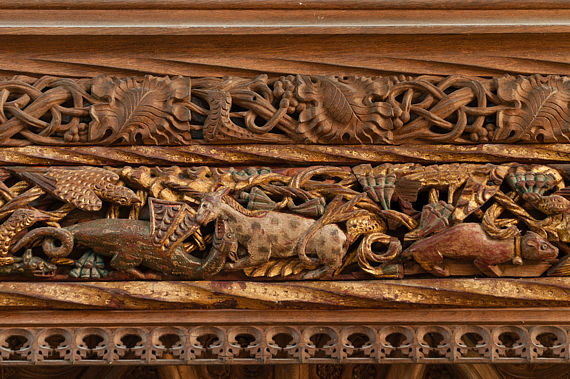St Buriana
Pulpit – Newspaper article (Western Morning News, 1905); 1905
This piece is not represented in the photographs at PWDRO but a newspaper report on an exhibition in Plymouth in 1905 of work by Rashleigh, Pinwill & Co. and designed by Edmund H. Sedding describes a pulpit for St Buryan church. It states that the design consisted of ‘Gothic tracery and foliage, some of the detail being similar to that on the old screen in the church, to be in keeping with it’ (Ibid. p. 8). The pulpit is similar to several others in Cornwall designed by Edmund H. Sedding and/or carved by the Pinwills. The cost of the pulpit was £60 (Warner, 2022).

Screen Restoration – Photographs (PWDRO 244/4 & 244/5); 1910
The church of St Buriana once boasted one of the best medieval screens in the County. The guide (Jago, 1998) suggests it may date from the mid to late fifteenth century but, as Beacham & Pevsner (2014) points out, the incorporation of the Godolphin arms means the screen must date from c. 1530 onwards. In 1814, however, it was mostly torn down and some of it carried away by parishioners for their own use. Fortunately, various pieces were thrown into the tower and others kept in a large wooden chest. The transformation of the church by the reinstatement of the screen is well-illustrated by a pair of photographs in PWDRO 244/4, showing the same view before and after. Not long before the restoration, Bond & Camm (1909) reported that the church had retained the lower portion of the screen and most of the carved beam that supported the rood loft on the west side, which is verified in the ‘before’ photograph. All the stored fragments were re-used and woven into new parts of the screen, to the designs of Edmund H. Sedding (Western Morning News, 1921). The old parts, which still retain their colour and gilding, were copied to create a faithful representation of the screen as it would have been. However, it is clear which sections are new, as no attempt was made to reproduce the colour and gilding. Also in 244/4 are two unannotated photographs, both of original parts of the screen, one showing a close-up of parts of the running ornament and the other some of the panels in the base.
It appears that only the central section of the screen was restored at this time and was dedicated by the Bishop of St Germans in January 1910. The ‘after’ photograph in PWDRO shows the completed screen in front of the chancel but with two carved beams only across the south and north sides. The guide states that the Lady Chapel section was restored a few years later by Belgian refugees and that the northern end was completed in 1922 as a WWI memorial.
The running ornament in the canopy is the crowning glory of the screen. It features an array of fantastical creatures, such as a spotted green serpent, black demons with red mouths, blue and gold striped birds and a speckled unicorn being attacked by a winged dragon, as well as more familiar animals and human faces, all tightly intertwined with vegetation. The ornament does not repeat itself and is a feast of medieval imagination.
Bond & Camm (1909), based on what remained prior to restoration, considered the screen at St Buryan to be one of two best examples of Cornish work, the other being at St Ewes. In contrast, Beacham & Pevsner (2014 p. 510) considered that what remained of the original work was enough to show that it ‘invites comparison with some of the best Devon screens of this period rather than local examples.’ The restoration work on this undoubtedly beautiful and unusual screen, whether made in Cornwall or Devon, was not without its critics. Not long after the restoration of the central portion, Cox (1912 p. 73) reported that through ‘a singular error of judgement, the true proportions… have been falsified, although traces of true levels are most obvious’. He did maintain, however, that the new carving work was excellent and well adapted to the original fragments.
Altar and Reredos – Church Guide (Jago, 1998); 1914
The reredos sits across the width of the east wall as a series of traceried panels and niches with saints that are echoed on the altar with ones for angels. The provenance of this work is known only from the church guide, which states that the altar and reredos were made by Miss Pinwill of Plymouth ‘responsible for much of the best wood carving in the west country in the early part of the 20th century’ (Jago, 1998 p. 15). They are dedicated to Canon Martyn who was rector of St Buryan from 1882 to 1913. A faculty exists for both items dated June 1914 (Kresen Kernow P23/2/11).
Sources
Beacham, P. & Pevsner, N. (2014) The Buildings of England. Cornwall. Yale University Press, London.
Bond, F. B. & Camm, D. B. (1909) Roodscreens and Roodlofts. Pitman & Sons, London.
Kresen Kernow P23/2/11 Faculty Petition. St Buryan. Altar and Reredos.
Cox, J. C. (1912) County Churches. Cornwall. George Allen & Co. Ltd, London.
Jago, C. (1998) “The Wickedest Parish” in Cornwall. A Short History & Guide Book. St Buryan Parish Church.
PWDRO 244/4 Photograph Album. Various. Woodcarvings.
PWDRO 244/5 Photograph Album. Various. Woodcarvings.
Warner, M. (2022) A Time to Build: Signposts to the Building, Restoration, Enhancement, and Maintenance of Cornwall’s Anglican Churches and Mission Rooms. Scyfa, Cornwall.
Western Morning News (1905) Exhibition of Wood-Carving in Plymouth. 15 February p. 8.
Western Morning News (1921) Mr. Edmund Sedding. Plymouth Architect’s Death in London. Work for Churches. 23 February p. 8.